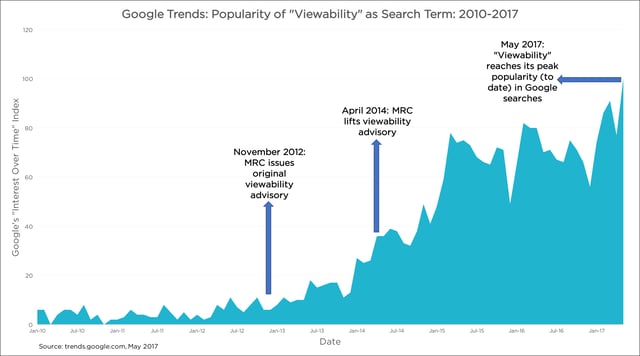
The Media Rating Council was founded in the 1960s following a congressional investigation into the accuracy of the audience measurement and research techniques in use at the time. Rather than establish regulatory oversight into media measurement, the committee proposed industry self-regulation and independent auditing as a solution, and the Media Rating Council was born with their stated mission to “secure for the media industry and related users audience measurement that is valid, reliable, and effective.”
To fulfill this mission, the MRC engages in both standards-setting activities and in conducting independent audits with third-party CPA firms in order to confirm compliance with such standards. Companies that have achieved compliance with a standard are certified as MRC-compliant for that specific standard.
In the late 2000s, various online advertising industry groups and some major players began to acknowledge an obvious drawback in the current state of the art in online advertising impression measurement. Ads — whether images, rich media, or other content — are downloaded to the page when the page loads, or when it refreshes, regardless of whether the portion of the page they are on is visible.
Advertisers were, therefore, paying for filled impressions — e.g. sold ad spaces — with no clue whether those ads actually had the opportunity to be seen by a human. What followed was a period of several years in which various viewable impression technologies and payment models entered the market. Several measurement standards were considered, until in early 2014, the MRC — in conjunction with the IAB — finalized their standard for viewable ads.
Per the MRC, viewable display ad impressions are counted when the following criteria are met:
Additionally, all such viewable ads must themselves be valid ad impressions before the viewability standard is applied. Ad impressions resulting from non-human activity, ad fraud, out of focus or obstructed pages, and significant auto-refresh activity are also considered not viewable.
The consistent application of the MRC viewability standard by measurement firms, buyers, and sellers has effectively reduced advertiser uncertainty in the programmatic advertising landscape.

Interest in viewability has increased over the years. Buyers and sellers are now entering into viewable-only contracts, in which non-viewable impressions are discounted from the ultimate payment. Private marketplaces have been created where only currently in-view ad opportunities are offered, and historical viewability percentages for sites, pages, and ad placements are taken into consideration by automated buying programs when deciding how much to bid.
As an MRC-accredited viewability vendor, Pixalate can provide the necessary data to fuel any number of viewability-based transactions entered into by parties in the advertising supply chain. And our Global Seller Trust Index (GSTI) leverages the viewability of ads sold as a key metric when scoring the overall trust of programmatic advertising sellers.
*By entering your email address and clicking Subscribe, you are agreeing to our Terms of Use and Privacy Policy.
These Stories on Thought Leadership
*By entering your email address and clicking Subscribe, you are agreeing to our Terms of Use and Privacy Policy.

Disclaimer: The content of this page reflects Pixalate’s opinions with respect to the factors that Pixalate believes can be useful to the digital media industry. Any proprietary data shared is grounded in Pixalate’s proprietary technology and analytics, which Pixalate is continuously evaluating and updating. Any references to outside sources should not be construed as endorsements. Pixalate’s opinions are just that - opinion, not facts or guarantees.
Per the MRC, “'Fraud' is not intended to represent fraud as defined in various laws, statutes and ordinances or as conventionally used in U.S. Court or other legal proceedings, but rather a custom definition strictly for advertising measurement purposes. Also per the MRC, “‘Invalid Traffic’ is defined generally as traffic that does not meet certain ad serving quality or completeness criteria, or otherwise does not represent legitimate ad traffic that should be included in measurement counts. Among the reasons why ad traffic may be deemed invalid is it is a result of non-human traffic (spiders, bots, etc.), or activity designed to produce fraudulent traffic.”

